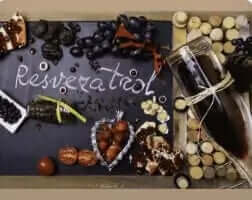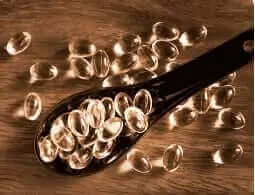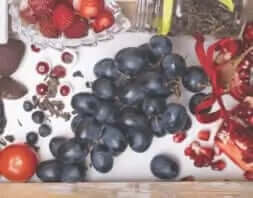Resveratrol Foods: Top 5 Natural Sources for Maximum Antioxidant Benefits and Health Optimization
Resveratrol has emerged as one of the most powerful and promising compounds in the world of health and longevity research. This remarkable antioxidant, naturally produced by plants as a defense mechanism against environmental stress, offers extraordinary potential for supporting human health through its potent anti-inflammatory, cardioprotective, and anti-aging properties. Understanding the best natural sources of resveratrol empowers you to harness these benefits through strategic dietary choices that can transform your health trajectory.
The growing excitement around resveratrol stems from its unique ability to activate longevity pathways, support cardiovascular health, and provide cellular protection against the damaging effects of aging. Unlike many other antioxidants that offer limited benefits, resveratrol works through multiple mechanisms to promote optimal health, making it one of the most valuable compounds you can incorporate into your wellness routine.
Discovering the richest natural sources of resveratrol allows you to maximize your intake of this powerful compound while enjoying delicious, nutritious foods that support overall health. From the celebrated benefits of red wine to the surprising resveratrol content in everyday foods like peanuts, this comprehensive guide reveals the best resveratrol sources and practical strategies for incorporating them into your daily diet for optimal health benefits.
Understanding Resveratrol: The Science Behind This Powerful Antioxidant
Resveratrol belongs to a class of compounds called polyphenols, specifically stilbenes, which plants produce as natural antibiotics to protect against bacterial and fungal infections. This phytoalexin demonstrates remarkable versatility in supporting human health through its ability to modulate multiple biological pathways simultaneously, including inflammation, oxidative stress, and cellular aging processes.
The compound exists in two primary forms: trans-resveratrol and cis-resveratrol, with trans-resveratrol being the more bioactive and beneficial form. This distinction becomes important when evaluating food sources and supplements, as the trans form provides the majority of resveratrol's health benefits that have made it famous in longevity research.
Research has identified resveratrol's ability to activate sirtuins, often called "longevity genes," which play crucial roles in cellular repair, metabolism, and aging processes. This activation may help explain many of resveratrol's observed benefits, including improved cardiovascular health, enhanced metabolic function, and potential life-extending properties demonstrated in various studies.
The antioxidant properties of resveratrol extend beyond simple free radical scavenging to include modulation of inflammatory pathways, support for healthy blood flow, and protection of cellular structures against age-related damage. These comprehensive effects make resveratrol a uniquely valuable compound for those seeking to optimize their health and longevity through natural means.
Top 5 Resveratrol Food Sources: Natural Powerhouses for Optimal Health
1. Red Wine: The Celebrated Source of Resveratrol
Red wine stands as perhaps the most famous source of resveratrol, thanks to extensive research highlighting the "French Paradox" - the observation that French populations consuming moderate amounts of red wine showed lower rates of heart disease despite diets high in saturated fats. The resveratrol in red wine comes from grape skins that remain in contact with the juice during fermentation, allowing the compound to concentrate in the finished wine.
The resveratrol content in red wine varies significantly based on grape variety, growing conditions, and winemaking processes, typically ranging from 0.2 to 5.8 milligrams per liter. Pinot Noir generally contains higher levels of resveratrol compared to other red wine varieties, while wines from cooler climates often show increased resveratrol concentrations due to environmental stress on the grapes.
While red wine offers notable resveratrol content, moderation remains crucial for maximizing benefits while minimizing potential risks associated with alcohol consumption. The recommended approach involves limiting consumption to one glass daily for women and up to two glasses for men, allowing you to gain resveratrol benefits while maintaining healthy alcohol intake levels.
For those who prefer to avoid alcohol, grape juice made from dark grape varieties can provide resveratrol benefits without alcohol content, though concentrations may be lower than in fermented wine. The key lies in choosing products made from whole grapes rather than concentrates to maximize resveratrol retention.
2. Dark Grapes: Nature's Resveratrol Powerhouse
Dark grapes, particularly those with deep purple or black skins, represent one of the richest natural sources of resveratrol available in whole food form. The compound concentrates primarily in grape skins, making dark-skinned varieties significantly higher in resveratrol compared to lighter colored grapes. Research indicates that dark grapes can contain ten times more resveratrol than blueberries, making them exceptional choices for maximizing resveratrol intake.
The historical significance of grapes extends back to ancient civilizations, with Egyptian pharaohs believing in their anti-aging and complexion-clearing properties. Modern science has validated many of these traditional beliefs, confirming that grapes provide abundant free radical-fighting antioxidants along with their impressive resveratrol content.
Fresh consumption of dark grapes provides the most reliable way to obtain resveratrol from this source, as processing can reduce concentrations. Organic grapes may offer additional benefits by avoiding pesticide residues while potentially containing higher antioxidant levels due to natural stress responses in the plants.
The versatility of grapes makes them easy to incorporate into daily nutrition routines, whether enjoyed fresh as snacks, added to salads, or incorporated into smoothies. Their natural sweetness and convenient portability make them ideal for consistent resveratrol intake throughout busy schedules.
3. Cranberries: Tart Treasures Packed with Resveratrol
Cranberries deliver impressive resveratrol content alongside their well-known benefits for urinary tract health and immune system support. These tart berries contain significant concentrations of resveratrol while providing additional antioxidants that work synergistically to enhance overall health benefits. Scientific research has demonstrated cranberries' ability to support metabolism and promote clear, healthy skin through their rich antioxidant profile.
Pure cranberry juice represents an excellent way to consume therapeutic amounts of resveratrol, though it's crucial to choose unsweetened varieties to avoid added sugars that can counteract health benefits. Many commercial cranberry products contain high fructose corn syrup or other sweeteners that dilute the beneficial compounds while adding unnecessary calories.
Fresh or frozen cranberries offer the highest concentrations of resveratrol and can be incorporated into various recipes, from smoothies and baked goods to savory dishes and sauces. Their intense flavor profile makes them particularly suitable for combination with other fruits or ingredients that can balance their natural tartness.
Dried cranberries can provide convenience for portable snacking, though it's important to select unsweetened varieties when possible. The concentration process involved in drying can actually increase resveratrol density per serving, making them efficient sources of the compound when fresh options aren't available.
4. Blueberries: Antioxidant Superstars with Resveratrol Benefits
While blueberries contain more modest amounts of resveratrol compared to grapes or cranberries, they still provide valuable quantities of this beneficial compound alongside their impressive array of other antioxidants. The combination of resveratrol with anthocyanins, the compounds responsible for blueberries' deep blue color, creates synergistic effects that enhance overall antioxidant protection and health benefits.
Blueberries have earned their reputation as a superfood through extensive research demonstrating their benefits for brain health, cardiovascular function, and overall longevity. The resveratrol content, while not the highest among berry sources, contributes to these comprehensive health effects and makes blueberries valuable additions to any resveratrol-focused nutrition plan.
The year-round availability of both fresh and frozen blueberries makes them convenient choices for consistent resveratrol intake. Frozen blueberries often retain their nutritional value exceptionally well and can be more economical than fresh varieties, especially during off-seasons.
Incorporating blueberries into daily nutrition routines proves simple and enjoyable, whether added to breakfast cereals, yogurt, smoothies, or consumed as standalone snacks. Their mild, sweet flavor makes them appealing to most palates while delivering consistent antioxidant benefits.
5. Peanuts: The Surprising Resveratrol Source
Peanuts represent one of the most unexpected yet significant sources of resveratrol, containing notable amounts of this beneficial compound in a convenient, shelf-stable form. This discovery has elevated peanuts from simple snack foods to recognized sources of heart-healthy antioxidants that can contribute meaningfully to overall resveratrol intake.
The resveratrol in peanuts concentrates primarily in the skins, making whole peanuts with skins attached the optimal choice for maximizing intake. Natural peanut butter made from whole peanuts can also provide resveratrol benefits, though processing may reduce concentrations compared to whole nuts.
Research has validated the heart-healthy benefits of moderate peanut consumption, with studies showing improvements in cholesterol profiles and cardiovascular risk factors. The combination of resveratrol with healthy fats, protein, and other beneficial compounds makes peanuts valuable additions to heart-healthy eating patterns.
Portion control remains important with peanuts due to their caloric density, but reasonable servings of 1-2 ounces daily can provide resveratrol benefits while supporting overall nutrition goals. Choosing dry-roasted varieties without added oils or excessive salt maximizes health benefits while minimizing unnecessary additives.
Additional Noteworthy Resveratrol Sources
Dark Chocolate: Sweet Resveratrol Benefits
High-quality dark chocolate, particularly varieties containing 70% or higher cacao content, provides meaningful amounts of resveratrol alongside other beneficial compounds like flavonoids and theobromine. The resveratrol content in chocolate varies based on cacao percentage and processing methods, with less processed varieties generally retaining higher levels.
Combining the pleasure of chocolate consumption with resveratrol benefits makes dark chocolate an appealing option for those seeking to enhance their antioxidant intake. Moderate consumption of 1-2 ounces of high-quality dark chocolate can contribute to overall resveratrol goals while providing additional cardiovascular and cognitive benefits.
Pomegranates: Ancient Fruits with Modern Benefits
Pomegranates contain resveratrol along with other powerful antioxidants like ellagic acid and punicalagins, creating comprehensive antioxidant protection. Both the arils (seeds) and juice provide resveratrol, though concentrations may vary based on variety and processing methods.
The historical use of pomegranates in traditional medicine systems aligns with modern research demonstrating their health benefits, including cardiovascular support, anti-inflammatory effects, and potential anti-aging properties. Their unique flavor profile and versatility make them valuable additions to resveratrol-focused nutrition plans.
Maximizing Resveratrol Absorption and Benefits
Optimal Consumption Strategies
Maximizing the benefits of resveratrol from food sources requires understanding factors that influence absorption and bioavailability. Consuming resveratrol-rich foods with healthy fats can enhance absorption, as resveratrol is a fat-soluble compound. This makes combinations like grapes with nuts or dark chocolate with moderate amounts an ideal approach.
Timing of consumption can also influence resveratrol benefits, with some research suggesting that spreading intake throughout the day may provide more consistent antioxidant protection compared to consuming large amounts at once. This approach also aligns well with natural eating patterns and helps maintain steady antioxidant levels.
Combining Foods for Synergistic Effects
Certain food combinations can enhance resveratrol's effectiveness through synergistic interactions with other beneficial compounds. Pairing resveratrol-rich foods with sources of quercetin (like onions or apples) or curcumin (from turmeric) may amplify anti-inflammatory and antioxidant effects.
The concept of food synergy suggests that whole foods provide benefits beyond their individual components, making diverse, resveratrol-rich eating patterns potentially more beneficial than focusing on single sources. This approach also ensures broader nutritional benefits while maximizing resveratrol intake.
Practical Implementation: Building a Resveratrol-Rich Diet
Daily Meal Planning Strategies
Incorporating multiple resveratrol sources throughout the day ensures consistent intake while preventing boredom with repetitive food choices. A practical approach might include berries with breakfast, grape snacks during the day, and moderate red wine consumption with dinner for those who choose to include alcohol.
Seasonal variations in resveratrol-rich foods allow for diverse meal planning that takes advantage of peak freshness and flavors. Summer berry seasons, fall grape harvests, and year-round availability of peanuts and cranberries provide options for every season.
Supplement Considerations
While food sources provide valuable resveratrol along with other beneficial compounds, achieving therapeutic levels (typically 150-500mg daily) through diet alone can be challenging. High-quality resveratrol supplements can complement food sources to ensure adequate intake for optimal health benefits.
When choosing supplements, look for trans-resveratrol content, third-party testing for purity, and enhanced delivery systems that improve bioavailability. Combining supplement use with resveratrol-rich foods often provides the most comprehensive approach to maximizing benefits.
Understanding Resveratrol Research and Health Benefits
Extensive research has documented resveratrol's potential benefits for cardiovascular health, with studies showing improvements in blood flow, cholesterol profiles, and markers of inflammation. The compound's ability to support healthy endothelial function contributes to its cardiovascular protective effects.
Longevity research has highlighted resveratrol's potential to activate cellular pathways associated with increased lifespan and healthspan. While human longevity studies require decades to complete, cellular and animal research provides compelling evidence for resveratrol's anti-aging potential.
Cognitive health benefits have also emerged from resveratrol research, with studies suggesting improvements in memory, learning, and protection against neurodegenerative processes. These effects may result from resveratrol's anti-inflammatory properties and support for healthy blood flow to the brain.
Video Guide: Resveratrol Food Sources
Watch: Top 5 Resveratrol Foods for Maximum Health Benefits
Learn about the best natural sources of resveratrol and practical tips for incorporating them into your daily diet. This comprehensive video guide covers all five top resveratrol sources with actionable advice for optimizing your intake.
Duration: Approximately 5 minutes
Safety Considerations and Potential Interactions
Resveratrol from natural food sources is generally safe for most people when consumed as part of a balanced diet. However, individuals taking blood-thinning medications should consult healthcare providers before significantly increasing resveratrol intake, as the compound may enhance anticoagulant effects.
Those with hormone-sensitive conditions should also seek medical guidance, as resveratrol may have mild estrogenic effects in some individuals. While these effects are generally minimal with food sources, awareness and professional consultation ensure safe implementation.
Moderation remains key with all resveratrol sources, particularly those like red wine and chocolate that contain other active compounds or calories that require consideration within overall dietary patterns. Balance and variety provide the best approach to maximizing benefits while minimizing any potential risks.
Frequently Asked Questions About Resveratrol Food Sources
What foods contain the highest amounts of resveratrol?
Red wine and dark grapes contain the highest concentrations of resveratrol, with red wine providing approximately 0.2-5.8 mg per liter. Other excellent sources include cranberries, blueberries, peanuts, and dark chocolate. The concentration varies based on growing conditions and processing methods.
How much resveratrol should I consume daily for health benefits?
Research suggests optimal resveratrol intake ranges from 150-500mg daily for health benefits. However, achieving therapeutic levels through food alone can be challenging, as you'd need to consume large quantities. Many people combine resveratrol-rich foods with high-quality supplements for optimal benefits.
Is red wine the best source of resveratrol?
While red wine is rich in resveratrol due to grape skin fermentation, it's not necessarily the 'best' source due to alcohol content and caloric density. Dark grapes, grape juice, and resveratrol supplements can provide similar benefits without alcohol. Moderation is key if choosing wine as a resveratrol source.
Do blueberries contain significant amounts of resveratrol?
Blueberries do contain resveratrol, but in relatively modest amounts compared to grapes or cranberries. However, they're still valuable for overall antioxidant intake and provide numerous other beneficial compounds like anthocyanins and pterostilbene that complement resveratrol's effects.
Can I get enough resveratrol from food alone?
While resveratrol-rich foods provide valuable nutrition, achieving therapeutic levels (150-500mg daily) through diet alone is challenging. For example, you'd need to drink several glasses of red wine daily, which isn't recommended. Combining resveratrol foods with quality supplements often provides the best approach.
What are the proven health benefits of resveratrol from food sources?
Research shows resveratrol from food sources supports cardiovascular health, provides anti-inflammatory effects, may support longevity, and offers antioxidant protection. Studies indicate benefits for heart health, brain function, metabolic health, and cellular protection against aging-related damage.
Are there any side effects from consuming resveratrol-rich foods?
Resveratrol from natural food sources is generally safe for most people. However, some individuals may experience mild digestive upset with large amounts. Those taking blood-thinning medications should consult healthcare providers, as resveratrol may enhance anticoagulant effects.
How does cooking affect resveratrol content in foods?
Cooking can reduce resveratrol content in some foods, though the effect varies by cooking method and duration. Light cooking or steaming generally preserves more resveratrol than high-heat methods. Raw consumption of resveratrol-rich foods like grapes and berries maximizes intake.
What's the difference between resveratrol from foods vs supplements?
Food sources provide resveratrol along with other beneficial compounds and fiber, creating synergistic effects. Supplements offer higher concentrations and standardized doses but may lack the complementary nutrients found in whole foods. The ideal approach often combines both for comprehensive benefits.
Which form of resveratrol is most bioavailable?
Trans-resveratrol is the most bioactive form, found naturally in grape skins and red wine. Some foods contain cis-resveratrol, which has lower bioactivity. High-quality supplements often provide trans-resveratrol in enhanced delivery systems for improved absorption and effectiveness.
Your Path to Optimal Resveratrol Benefits
Incorporating resveratrol-rich foods into your daily nutrition routine represents a delicious and natural approach to supporting long-term health and vitality. The five power sources highlighted in this guide - red wine, dark grapes, cranberries, blueberries, and peanuts - provide accessible options for maximizing your resveratrol intake while enjoying diverse, flavorful foods that enhance overall nutrition quality.
The key to success lies in consistency and variety, ensuring that you regularly consume multiple resveratrol sources to maintain steady antioxidant protection while preventing dietary monotony. Whether you choose to enjoy a moderate glass of red wine with dinner, snack on fresh grapes during the day, or incorporate cranberries into your morning routine, each choice contributes to your overall resveratrol goals.
Remember that while food sources provide valuable resveratrol along with other beneficial compounds, achieving optimal therapeutic levels may require combining dietary sources with high-quality supplements. This comprehensive approach ensures you receive maximum benefits while enjoying the pleasure and nutrition that whole foods provide.
The journey toward optimal health through resveratrol begins with simple, achievable steps that can transform your daily nutrition routine. By prioritizing these evidence-based food sources and maintaining consistent consumption patterns, you're investing in your long-term health, vitality, and potential for healthy aging.
Start today by choosing one or two resveratrol-rich foods to incorporate into your routine, then gradually expand your repertoire as these choices become natural habits. Your future self will thank you for taking these proactive steps toward optimal health and longevity through the power of natural resveratrol sources.
References:
- https://portlandpress.com/biochemsoctrans/article-abstract/35/5/1156/86289
- https://www.ahajournals.org/doi/abs/10.1161/01.cir.0000029925.18593.5c
- https://pubs.acs.org/doi/abs/10.1021/jf034150f
- https://www.tandfonline.com/doi/abs/10.1080/10408398.2011.606928
- https://pubs.acs.org/doi/abs/10.1021/jf010812u
- https://journals.lww.com/cardiovascularpharm/Fulltext/2009/12000/Flavonoids_protect_LDL_from_oxidation_and.00002.aspx
- https://europepmc.org/article/med/7499059







